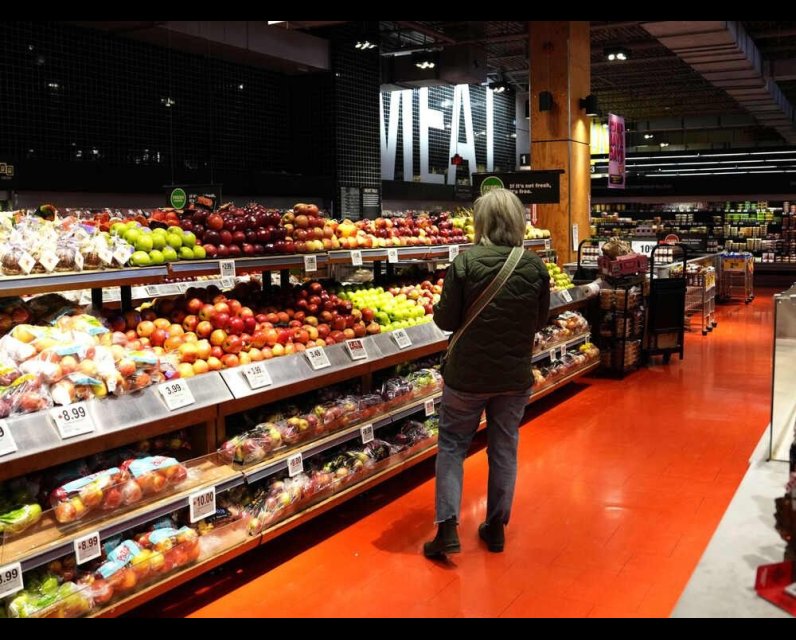The pandemic drove up inflation. How come, years later, we're still paying more?

What happened to those “short-term” price increases from the pandemic?
From 2021 to 2023, Canadians were told that prices jumped largely because of supply-chain bottlenecks, government spending on income supports and other pandemic-related issues.
If so, shouldn’t those temporary increases disappeared once the pandemic subsided and those glitches were repaired?
While inflation may have since been tamed, Statistics Canada’s monthly inflation figures show that the pandemic-era price hikes survived.
Are consumers getting ripped off by not seeing prices slide back again?
Under typical circumstances, we would have seen some inflation, likely within the Bank of Canada’s “normal” band of between one and three per cent a year, even without the pandemic. Instead, the Consumer Price Index saw the annual rate jolt to 3.4 per cent in 2021, soar to 6.8 per cent in 2022, and load another nearly four per cent onto prices in 2023. That additional inflation that was supposed to be because of the impacts of COVID-19.
Yet, more than five years after the deadly virus started to spread, and two years after the pandemic was declared over, we seem to still be paying for those price hikes. To find out why, National Post asked economists to shed some light on what happened to that “temporary” inflation and why we’re still paying for it.
Some blame corporate greed. Others, a lack of competition in some markets. Or are there other economic trends at work that suggest that consumers aren’t actually being ripped off at all?
What happened to consumer prices during the pandemic?According to Statistics Canada’s Consumer Price Index (CPI), prices rose 11.4 per cent between January 2020 and December 2022.
But that wasn’t an immediate response to the pandemic. Inflation didn’t spike for more than a year after the start of the pandemic. In fact, prices were rising at relatively normal and modest rates until May 2021, about 16 months after the first case of COVID-19 was reported in Canada, and didn’t peak until June 2022, at 8.1 per cent, the highest rate in almost four decades.
(The pandemic started in China in December 2019 and a pandemic was declared in Canada on March 11, 2020.)
Gasoline was among the products hit hardest by inflation, with a price increase of more than 50 per cent over that two-year period. Food and transportation jumped between 15 and 20 per cent, while appliances and rent each increased by between 10 and 15 per cent.
What caused inflation during the pandemic?Prices at any time are, in general terms, a function of supply and demand. In short, the pandemic caused both simultaneous supply shocks and increased consumer demand.
Barring innovation that leads to productivity improvements and lower costs, that formula will almost always mean price hikes.
On the supply side, some products were being produced less or not at all due to factories being closed or experiencing reduced hours, particularly in Asia. There were also shortages of some raw materials, such as lumber and metals, which also contributed to inflation.
And costs for many suppliers went up because transportation became more expensive due to shipping delays, congestion at many ports and the rising cost of fuel, which affects the prices of most products.
There were also supply problems that had little or nothing to do with the pandemic.
Russia invaded Ukraine in early 2022, reducing the global supply of energy products, fertilizer and some grains.
Some important agricultural areas also suffered from poor weather. In 2021, Western Canadian farmers were hit with the worst drought in 19 years, leading to wheat stocks to drop 38.7 per cent compared to the previous year. By April 2022, food manufacturers were paying more than double for wheat than they had been paying just two years earlier.
And as usual, those costs were borne by consumers. According to Statistics Canada , consumers had to spend considerably more on bread (+12.2 per cent), pasta (+19.6 per cent) and cereals (+13.9 per cent) than they had a year earlier.
On the demand side, consumers’ lives had changed because many started working from home, going out less and not travelling. That meant they were unintentionally saving money. Lower interest rates and billions of dollars in government support programs also put more money into consumers’ pockets.
Some employees, meanwhile, were getting fatter paycheques because there was greater demand for their services. Health care workers were pulling overtime shifts, for example. Also, as people adjusted to staying at home and renovated or bought new houses, construction workers were in high demand.
As consumers responded to the shapes of their new lives there was increased demand for real estate, furniture, exercise equipment and home entertainment gadgets .
Demand, and the upward pressure on inflation, was also fuelled by government spending.
A new report from the C.D. Howe Institute concluded that the Trudeau government’s spending splurges played a major role in fuelling inflation during the pandemic. The report pointed the finger at Ottawa’s unfunded spending spree — more than the Bank of Canada’s monetary policies — that acted as “helicopter drops” of money for the private sector.
In 2020, about 20.7 million Canadians out of an adult population of 30.3 million received income from one of the federal pandemic-related programs, according to a 2022 report. During that year alone, the programs are estimated to have cost $270 billion — about 12.5 per cent of Canada’s gross domestic product (GDP) — and cumulatively have cost about $360 billion to date.
While the programs broadly succeeded in providing relief to individuals and businesses and creating a cushion for the economy during a crisis, the C.D. Howe Institute noted that injecting that much extra money into an economy while unemployment is low results in inflation.
David Andolfatto, c hair of the department of economics at the University of Miami and an international fellow at the C.D. Howe Institute, said inflation should be expected when governments add that much extra demand to the economy. “Of course prices went up,” he said. “There’s no such thing as a free lunch. Somebody will have to pay.”
And not only do consumers pay higher prices but they must then pay again with the higher interest rates the central bank then implemented to try bringing those prices back down. In 2020, interest rates were down to 0.25 per cent as the Bank of Canada aimed to cushion the blow from the pandemic; by 2023, the rate had risen 20-fold, to five per cent.
Jean-Francois Perrault, chief economist at the Bank of Nova Scotia, estimated in a November 2023 report that government spending and pandemic-era transfers to Canadians were responsible for about 42 per cent (200 of the 475 basis points) of the increase in the Bank of Canada’s prime interest rate during that period. About one-third of those interest rate hikes can be traced back to provincial governments, he calculated.
“Our results suggest that fiscal policy at all levels of government has been badly miscalibrated,” the report concluded.
How much have prices gone up since the pandemic?Since the start of 2023, inflation has remained at less than four per cent, just over the Bank of Canada’s preferred band of between one and three per cent, but a big decrease from the peak of pandemic-era inflation.
And, at least for now, it’s largely under control. Statistics Canada reported last week that Canada’s inflation rate accelerated to 1.9 per cent in June, up from 1.7 per cent the previous month.
Why have some prices kept rising since the pandemic?When the pandemic subsided, it removed a number of shocks and disruptions to markets. But not all of them.
The Russian invasion of Ukraine, for example, still hasn’t been resolved. Many of the people who started working from home during the pandemic still do so, either part-time or full-time, which puts a little more money in most of their pockets. The glut of baby boomers is also at the stage of life where many are retiring, having saved up their money, and now want to spend it.
Katherine Judge, senior economist at CIBC Capital Markets said consumer markets are also still getting a boost from pent-up demand and extra savings that consumers accumulated during the pandemic.
Wages, meanwhile, have actually been growing faster than inflation since mid-2024, so household purchasing power has also increased.
In recent months, the tariff wars launched by U.S. President Donald Trump have started to put upward pressure on inflation in both components and finished goods and will continue to do so unless they are resolved.
Economists say that p rices don’t normally drop — or even approach inflation of less than one per cent — unless demand falls because the economy is in a recession or governments adopt severe cost-cutting measures.
Neither has happened since the pandemic. The federal government kept running large deficits in spending. And while it has spoken recently about cutting costs in the bureaucracy, it also plans to boost outlays on defence and infrastructure projects.
As poor weather played a role in fuelling inflation during the pandemic, it’s still a major factor.
A new study by a team of international scientists led by Maximillian Kotz, a postdoctoral fellow at the Barcelona Supercomputing Center, found that foods affected by heat, drought, floods and other climatic extremes contributed directly to higher consumer prices.
This summer, for example, farmers in southwestern Saskatchewan have been hit by wildfires, heat waves and drought, driving up prices in the wheat market. But weather isn’t just affecting the Canadian Prairies.
Severe weather events are also causing higher prices for Japanese rice and Spanish olive oil. In a phenomenon dubbed “heatflation,” the report also documents that South Korean cabbage prices rose 70 per cent last year after a period of hot weather and drought, and that seafood prices increased because rising water temperatures has meant fishermen have had smaller catches.
Will prices even come down again from the pandemic inflation?Is there a chance that some of the pandemic spike in prices could still be eliminated if the world enjoys a period of relative peace, with no disruptive shocks?
Andolfatto , at the University of Miami, said prices could in theory still come down in some markets, but that would be a function of changes in supply and demand at that time, not anything to do with what occurred during the pandemic.
But that’s unlikely to happen in Canada in the near term, Andolfatto said, because governments haven’t taken steps to reduce the extra demand in the economy.
But are corporations keeping prices artificially high?Many economists say they don’t believe that consumers, in broad terms, are being cheated. There may be some Canadian markets, such as banking, airlines or telecommunications services, where there are worries over a lack of competition. But in the markets that people usually point to when they think about inflation, groceries in particular, competition is robust. And the prices are, as is usually the case, largely a function of supply and demand.
“I’m not going to blame corporate greed for this phenomenon,” said Andolfatto . “Corporate greed was there before.”
National Post
stuck@postmedia.com
Our website is the place for the latest breaking news, exclusive scoops, longreads and provocative commentary. Please bookmark nationalpost.com and sign up for our politics newsletter, First Reading, here.



Comments
Be the first to comment